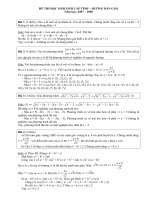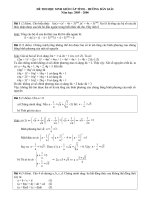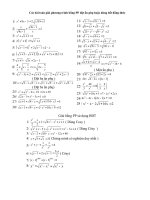Đáp Án Bài Tập Nhập Môn Tài Chính Tiền Tệ 3 Diệp Gia Luật
Bạn đang xem bản rút gọn của tài liệu. Xem và tải ngay bản đầy đủ của tài liệu tại đây (40.18 KB, 5 trang )
ĐÁP ÁN BÀI TẬP NHẬP MÔN TÀI
CHÍNH TIỀN TỆ - BUỔI 3
Giảng viên: Diệp Gia Luật
Câu 1: Periodic payments of net earnings to shareholders are known as
A) capital gains.
B) dividends.
C) profits.
D) interest.
Answer: B
Câu 2: The value of any investment is found by computing the
A) present value of all future sales.
B) present value of all future liabilities.
C) future value of all future expenses.
D) present value of all future cash flows.
Answer: D
Câu 3: In the one-period valuation model, the value of a share of stock today depends upon
A) the present value of both the dividends and the expected sales price.
B) only the present value of the future dividends.
C) the actual value of the dividends and expected sales price received in one year.
D) the future value of dividends and the actual sales price.
Answer: A
Câu 4: In the one-period valuation model, the current stock price increases if
A) the expected sales price increases.
B) the expected sales price falls.
C) the required return increases.
D) dividends are cut.
Answer: A
Câu 5: In the one-period valuation model, an increase in the required return on investments in
equity
A) increases the expected sales price of a stock.
B) increases the current price of a stock.
C) reduces the expected sales price of a stock.
D) reduces the current price of a stock.
Câu 6: Using the one-period valuation model, assuming a year-end dividend of $0.11, an
expected sales price of $110, and a required rate of return of 10%, the current price of the stock
would be
A) $110.11.
B) $121.12.
C) $100.10.
D) $100.11
Câu 7: Using the one-period valuation model, assuming a year-end dividend of $1.00, an
expected sales price of $100, and a required rate of return of 5%, the current price of the stock
would be
A) $110.00.
B) $101.00.
C) $100.00.
D) $96.19.
Câu 8: Using the Gordon growth model, a stock's price will increase if
A) the dividend growth rate increases.
B) the growth rate of dividends falls.
C) the required rate of return on equity rises.
D) the expected sales price rises.
Câu 9: Using the Gordon growth model, a stock's current price decreases when
A) the dividend growth rate increases.
B) the required return on equity decreases.
C) the expected dividend payment increases.
D) the growth rate of dividends decreases.
Câu 10: In the Gordon growth model, a decrease in the required rate of return on equity
A) increases the current stock price.
B) increases the future stock price.
C) reduces the future stock price.
D) reduces the current stock price.
Câu 11: Using the Gordon growth formula, if D1 is $2.00, ke is 12% or 0.12, and g is 10% or
0.10, then the current stock price is
A) $20.
B) $50.
C) $100.
D) $150.
Câu 12: Using the Gordon growth model, if D1 is $.50, ke is 7%, and g is 5%, then the present
value of the stock is
A) $2.50.
B) $25.
C) $50.
D) $46.73.
Câu 14: One of the assumptions of the Gordon Growth Model is that dividends will continue
growing at ________ rate.
A) an increasing
B) a fast
C) a constant
D) an escalating
Câu 15: In the Gordon Growth Model, the growth rate is assumed to be ________ the required
return on equity.
A) greater than
B) equal to
C) less than
D) proportional to
Câu 16: You believe that a corporation's dividends will grow 5% on average into the foreseeable
future. If the company's last dividend payment was $5 what should be the current price of the
stock assuming a 12% required return?
Answer: Use the Gordon Growth Model.
Câu 17: In asset markets, an asset's price is
A) set equal to the highest price a seller will accept.
B) set equal to the highest price a buyer is willing to pay.
C) set equal to the lowest price a seller is willing to accept.
D) set by the buyer willing to pay the highest price.
Câu 18: Information plays an important role in asset pricing because it allows the buyer to more
accurately judge
A) liquidity.
B) risk.
C) capital.
D) policy.
Câu 19: A stock's price will fall if there is
A) a decrease in perceived risk.
B) an increase in the required rate of return.
C) an increase in the future sales price.
D) current dividends are high.
Câu 20: New information that might lead to a decrease in a stock's price might be
A) an expected decrease in the level of future dividends.
B) a decrease in the required rate of return.
C) an expected increase in the dividend growth rate.
D) an expected increase in the future sales price.
Câu 21: The global financial crisis lead to a decline in stock prices because
A) of a lowered expected dividend growth rate.
B) of a lowered required return on investment in equity.
C) higher expected future stock prices.
D) higher current dividends.
Câu 22: Increased uncertainty resulting from the global financial crisis ________ the required
return on investment in equity.
A) raised
B) lowered
C) had no impact on
D) decreased
Câu 23: The Efficient Market Hypothesis: Rational Expectations in Financial Markets
1) The theory of rational expectations, when applied to financial markets, is known as
A) monetarism.
B) the efficient markets hypothesis.
C) the theory of strict liability.
D) the theory of impossibility.
Câu 24: According to the efficient markets hypothesis, the current price of a financial security
A) is the discounted net present value of future interest payments.
B) is determined by the highest successful bidder.
C) fully reflects all available relevant information.
D) is a result of none of the above.
Câu 25: The efficient markets hypothesis suggests that if an unexploited profit opportunity arises
in an efficient market,
A) it will tend to go unnoticed for some time.
B) it will be quickly eliminated.
C) financial analysts are your best source of this information.
D) prices will reflect the unexploited profit opportunity.
Đáp án buổi 3
1 b 2d 3a 4a 5d 6c 7d 8a 9d 10a 11c 12b 14 b 15c 16: 75$ 17d 18b 19b 20a 21a 22a 23b 24c 25b









